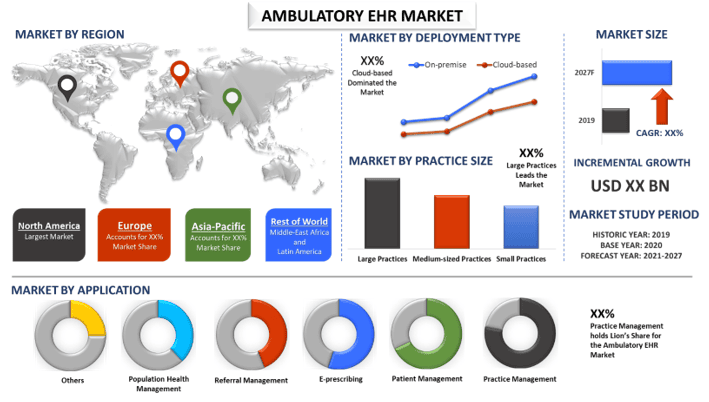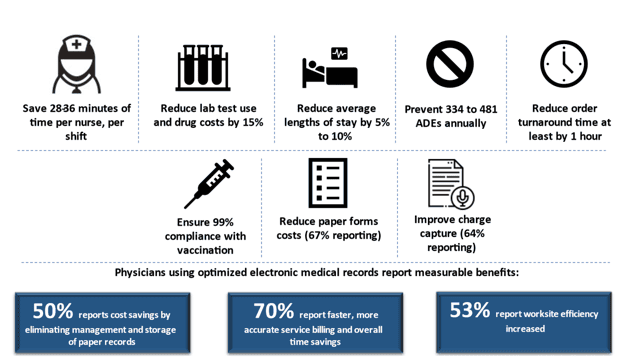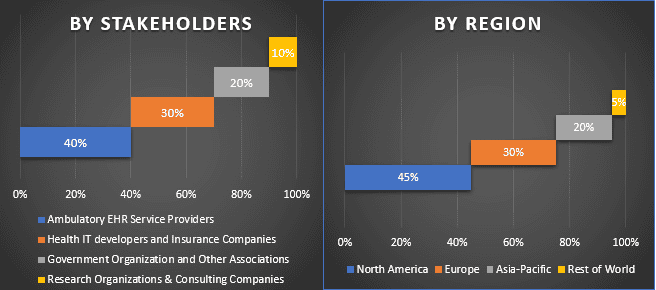
전 세계 외래 환자 EHR 시장은 예측 기간(2021-2027) 동안 약 6%의 높은 연평균 성장률로 성장할 것으로 예상됩니다.외래 환자 EHR은 외래 환자 치료 시설 및 소규모 진료에 도움을 제공합니다. 이는 병원의 복잡한 웹과 상호 작용하지 않고도 의사가 환자의 의료 기록 및 장기 치료를 추적할 수 있도록 해주기 때문에 입원 환자 EHR보다 훨씬 간단합니다.
헬스케어 부문에서 생성되는 데이터는 방대하며 이 데이터를 관리해야 할 필요성이 날마다 극적으로 증가하고 있습니다.매초마다 막대한 양의 헬스케어 데이터가 생성되고 있으며, 이를 통해 귀중한 통찰력을 얻을 수 있습니다. 현재 전 세계 데이터 볼륨의 약 30%가 헬스케어 산업에서 생성되고 있으며, 2025년까지 헬스케어 데이터의 연평균 성장률이 36%에 이를 것으로 예상됩니다.따라서 이 방대한 데이터 묶음에서 약물 오류율을 최소화하고 데이터 관리 비용을 줄이기 위해 많은 의료 기관에서 물리적 문서 기록보다 더 나은 대안으로 EHR을 배포하고 있습니다.
더욱이 외래 환자 EHR 시장은 의료 종사자가 구조화된 형식으로 데이터를 저장하기 위해 전자 건강 기록(EHR)을 필요로 하므로 환자 데이터를 효과적으로 캡처하고 공유하기 위해 EHR이 제공하는 여러 이점으로 인해 성장할 것으로 예상됩니다. 이 구조화된 데이터는 의료 종사자가 환자 정보를 쉽게 전송하고 검색하는 데 도움이 됩니다.
전자 의료 기록의 임상 최적화 목표 및 이점

McKesson Corporation, Allscripts Healthcare Solutions, Inc., Athenahealth, Greenway Health LLC, Cerner Corporation, EPIC Systems Corporation, Cure MD, NetSmart Technologies, eClinicalWorks, Nextgen Healthcare Information Systems LLC는 외래 환자 EHR 시장에서 활동하는 주요 업체 중 일부입니다. 이러한 업체들은 고객에게 외래 환자 EHR을 제공하기 위해 여러 M&A와 파트너십을 체결했습니다.
보고서에 제시된 통찰력
“배포 유형 중 클라우드 기반 부문이 주요 점유율을 차지합니다.”
배포 유형에 따라 외래 환자 EHR 시장은 온프레미스와 클라우드 기반으로 양분됩니다. 클라우드 기반 부문은 2020년에 가장 큰 시장 점유율을 차지했으며 최종 사용자에게 높은 유연성을 제공하고 비용 효율적이기 때문에 예측 기간 동안 가장 높은 연평균 성장률을 보일 것으로 예상됩니다. 또한 낮은 설치 비용과 이 소프트웨어가 자체 유지 관리의 필요성을 없앨 수 있다는 점도 이 부문의 성장에 기여하는 주요 요인 중 하나입니다.
“애플리케이션 중 진료 관리 부문이 주요 점유율을 차지합니다.”
애플리케이션을 기준으로 외래 환자 EHR 시장은 진료 관리, 환자 관리, E-처방, 의뢰 관리, 인구 건강 관리 등으로 세분화됩니다. 진료 관리 부문은 2020년에 외래 환자 EHR 시장의 주요 점유율을 차지했으며 운영 비용을 절감하는 고급 의료 소프트웨어 및 고급 기능의 채택이 증가함에 따라 향후 몇 년 동안 상당한 연평균 성장률로 성장할 것으로 예상됩니다.
“진료 규모 중 대규모 진료 부문이 주요 점유율을 차지합니다.”
진료 규모를 기준으로 시장은 대규모 진료, 중규모 진료, 소규모 진료로 나뉩니다. 2020년에는 대규모 진료 부문이 상당한 시장 점유율을 확보했으며 새로운 EHR 채택으로 인해 발생할 수 있는 생산성 문제를 해결할 수 있기 때문에 예측 기간 동안 상당한 연평균 성장률로 성장할 것으로 예상됩니다.
“최종 사용자 중 의사 부문이 주요 점유율을 차지합니다.”
최종 사용자를 기준으로 시장은 병원 소유 외래 센터와 독립 센터로 나뉩니다. 2020년에는 병원 소유 외래 센터 부문이 상당한 시장 점유율을 확보했으며 예측 기간 동안 상당한 연평균 성장률로 성장할 것으로 예상됩니다. 이 부문의 성장은 병원 외래 센터에서 생성되는 막대한 양의 헬스케어 데이터를 구성해야 할 필요성이 증가함에 따라 외래 환자 EHR의 인기가 높아지고 있기 때문입니다.
“북미는 외래 환자 EHR 시장의 가장 큰 시장 중 하나입니다.”
외래 환자 EHR 시장의 시장 역학에 대한 더 나은 이해를 위해 북미(미국, 캐나다 및 북미 지역 나머지), 유럽(독일, 프랑스, 스페인, 영국, 이탈리아 및 유럽 지역 나머지), 아시아 태평양(중국, 인도, 호주, 일본 및 APAC 지역 나머지), 세계 지역 나머지를 포함하여 전 세계 여러 지역에 대해 자세한 분석이 수행되었습니다. 북미는 외래 환자 EHR 시장 산업의 주요 시장을 구성하며, 강력한 의료 인프라와 해당 지역의 의료 산업에서 첨단 기술 솔루션의 채택이 증가함에 따라 2020년에 XX 백만 달러의 수익을 창출했습니다.
이 보고서를 구매해야 하는 이유:
- 이 연구에는 인증된 주요 업계 전문가가 검증한 시장 규모 조정 및 예측 분석이 포함되어 있습니다.
- 이 보고서는 전체 산업 성과에 대한 빠른 검토를 한눈에 제공합니다.
- 이 보고서는 주요 비즈니스 재무, 제품 포트폴리오, 확장 전략 및 최근 개발에 대한 주요 초점을 두고 저명한 업계 동료에 대한 심층 분석을 다룹니다.
- 업계에 만연한 동인, 제약, 주요 추세 및 기회에 대한 자세한 조사
- 이 연구는 다양한 부문에 걸쳐 시장을 포괄적으로 다룹니다.
- 산업에 대한 심층적인 지역 수준 분석
맞춤화 옵션:
글로벌 외래 환자 EHR 시장은 요구 사항 또는 기타 시장 부문에 따라 추가로 맞춤화할 수 있습니다. 이 외에도 UMI는 귀하가 고유한 비즈니스 요구 사항을 가지고 있음을 이해하므로 귀하의 요구 사항에 완전히 적합한 보고서를 얻기 위해 언제든지 저희에게 연락하십시오.
목차
글로벌 외래 환자 EHR 시장의 과거 시장 분석, 현재 시장 추정 및 미래 시장 예측은 전 세계 주요 지역에서 외래 환자 EHR 채택을 생성하고 분석하기 위해 수행된 세 가지 주요 단계였습니다. 과거 시장 수치를 수집하고 현재 시장 규모를 추정하기 위해 철저한 2차 연구가 수행되었습니다. 둘째, 이러한 통찰력을 검증하기 위해 수많은 조사 결과와 가정이 고려되었습니다. 또한 글로벌 외래 환자 EHR 시장의 가치 사슬 전반에 걸쳐 업계 전문가와 함께 철저한 1차 인터뷰도 수행되었습니다. 1차 인터뷰를 통해 시장 수치를 가정하고 검증한 후에는 전체 시장 규모를 예측하기 위해 하향식/상향식 접근 방식을 사용했습니다. 그 후, 시장 세분화 및 데이터 삼각 측량 방법을 채택하여 산업과 관련된 부문 및 하위 부문의 시장 규모를 추정하고 분석했습니다. 자세한 방법론은 아래에 설명되어 있습니다.
과거 시장 규모 분석
1단계: 2차 출처에 대한 심층 연구:
외래 환자 EHR의 과거 시장 규모를 얻기 위해 다음과 같은 회사 내부 소스를 통해 자세한 2차 연구가 수행되었습니다.연간 보고서 및 재무 제표, 실적 발표, 보도 자료 등다음과 같은 외부 소스를 포함합니다.저널, 뉴스 및 기사, 정부 간행물, 경쟁사 간행물, 부문 보고서, 타사 데이터베이스 및 기타 신뢰할 수 있는 간행물.
2단계: 시장 세분화:
외래 환자 EHR 시장의 과거 시장 규모를 확보한 후 주요 지역에 대한 다양한 부문 및 하위 부문에 대한 과거 시장 통찰력과 점유율을 수집하기 위해 자세한 2차 분석을 수행했습니다. 보고서에 포함된 주요 부문은 배포 유형, 애플리케이션, 진료 규모 및 최종 사용자입니다. 또한 전 세계 외래 환자 EHR 채택 전반을 평가하기 위해 국가 수준 분석이 수행되었습니다.
3단계: 요인 분석:
다양한 부문 및 하위 부문의 과거 시장 규모를 확보한 후 자세한요인 분석진료 관리 시스템의 현재 시장 규모를 추정합니다. 또한 EHR 채택을 촉진하는 헬스케어 시스템 통합에 대한 증가하는 필요성과 같은 종속 및 독립 변수를 사용하여 요인 분석을 수행했습니다. 전 세계 외래 환자 EHR 부문에서 최고의 파트너십, 합병 및 인수, 사업 확장 및 제품 출시를 고려하여 수요 및 공급 측면 시나리오에 대한 철저한 분석이 수행되었습니다.
현재 시장 규모 추정 및 예측
현재 시장 규모 조정:위의 3단계에서 얻은 실행 가능한 통찰력을 바탕으로 현재 시장 규모, 외래 환자 EHR 시장의 주요 업체 및 부문의 시장 점유율에 도달했습니다. 필요한 모든 백분율 점유율 분할 및 시장 분석은 위에서 언급한 2차 접근 방식을 사용하여 결정되었으며 1차 인터뷰를 통해 검증되었습니다.
추정 및 예측:시장 추정 및 예측을 위해, 동인 및 트렌드, 제약 요인 및 이해 관계자에게 제공되는 기회를 포함한 다양한 요인에 가중치가 할당되었습니다. 이러한 요인들을 분석한 후, 2027년경의 시장 예측을 도출하기 위해, 즉, 주요 시장 전반의 다양한 세그먼트 및 하위 세그먼트에 대해 상향식/하향식 접근 방식과 같은 관련 예측 기법이 적용되었습니다. 시장 규모를 추정하기 위해 채택된 연구 방법론은 다음을 포함합니다:
- 주요 시장 내에서의 가치(US$) 측면의 산업 시장 규모 및 외래 환자 EHR 채택률
- 시장 세그먼트 및 하위 세그먼트의 모든 백분율 점유율, 분할 및 분석
- 제공되는 제품 측면의 외래 환자 EHR 시장의 주요 업체. 또한, 빠르게 성장하는 시장에서 경쟁하기 위해 이러한 업체들이 채택한 성장 전략
시장 규모 및 점유율 검증
1차 조사:주요 지역 전반의 최고 경영진(CXO/VP, 영업 책임자, 마케팅 책임자, 운영 책임자, 지역 책임자, 국가 책임자 등)을 포함한 주요 의견 리더(KOL)와의 심층 인터뷰가 진행되었습니다. 그런 다음 1차 조사 결과를 요약하고, 진술된 가설을 증명하기 위해 통계 분석을 수행했습니다. 1차 조사의 입력은 2차 조사 결과와 통합되어 정보를 실행 가능한 통찰력으로 전환했습니다.
다양한 지역의 1차 참가자 분할

시장 공학
데이터 삼각 측량 기법을 사용하여 전반적인 시장 추정을 완료하고 외래 환자 EHR 시장의 각 세그먼트 및 하위 세그먼트의 정확한 통계 수치를 도출했습니다. 배포 유형, 애플리케이션, 진료 규모 및 외래 환자 EHR 시장의 최종 사용자와 같은 다양한 매개변수 및 트렌드를 연구한 후 데이터는 여러 세그먼트 및 하위 세그먼트로 분할되었습니다.
외래 환자 EHR 시장 연구의 주요 목적
외래 환자 EHR의 현재 및 미래 시장 동향이 연구에서 정확히 지적되었습니다. 투자자는 연구에서 수행된 질적 및 양적 분석을 통해 투자를 위한 판단의 근거가 되는 전략적 통찰력을 얻을 수 있습니다. 현재 및 미래 시장 동향은 지역 수준에서 시장의 전반적인 매력을 결정하여 산업 참여자가 미개척 시장을 활용하여 선점 이점을 얻을 수 있는 플랫폼을 제공했습니다. 연구의 다른 양적 목표는 다음과 같습니다:
- 외래 환자 EHR의 현재 및 예측 시장 규모를 가치(US$) 측면에서 분석합니다. 또한, 다양한 세그먼트 및 하위 세그먼트의 현재 및 예측 시장 규모를 분석합니다.
- 연구의 세그먼트에는 배포 유형, 애플리케이션, 진료 규모 및 최종 사용자의 영역이 포함됩니다
- 외래 환자 EHR 산업에 대한 규제 프레임워크의 정의 및 분석
- 다양한 중개인의 존재와 관련된 가치 사슬을 분석하고 산업의 고객 및 경쟁업체 행동을 분석합니다.
- 주요 지역에 대한 외래 환자 EHR 시장의 현재 및 예측 시장 규모를 분석합니다.
- 보고서에서 연구된 주요 지역에는 북미, 유럽, 아시아 태평양 및 기타 지역이 포함됩니다.
- 외래 환자 EHR 시장의 회사 프로필 및 빠르게 성장하는 시장에서 지속하기 위해 시장 참여자가 채택한 성장 전략
- 산업의 심층 지역 수준 분석
관련 보고서
이 상품을 구매한 고객님들도 함께 구매하신 상품










